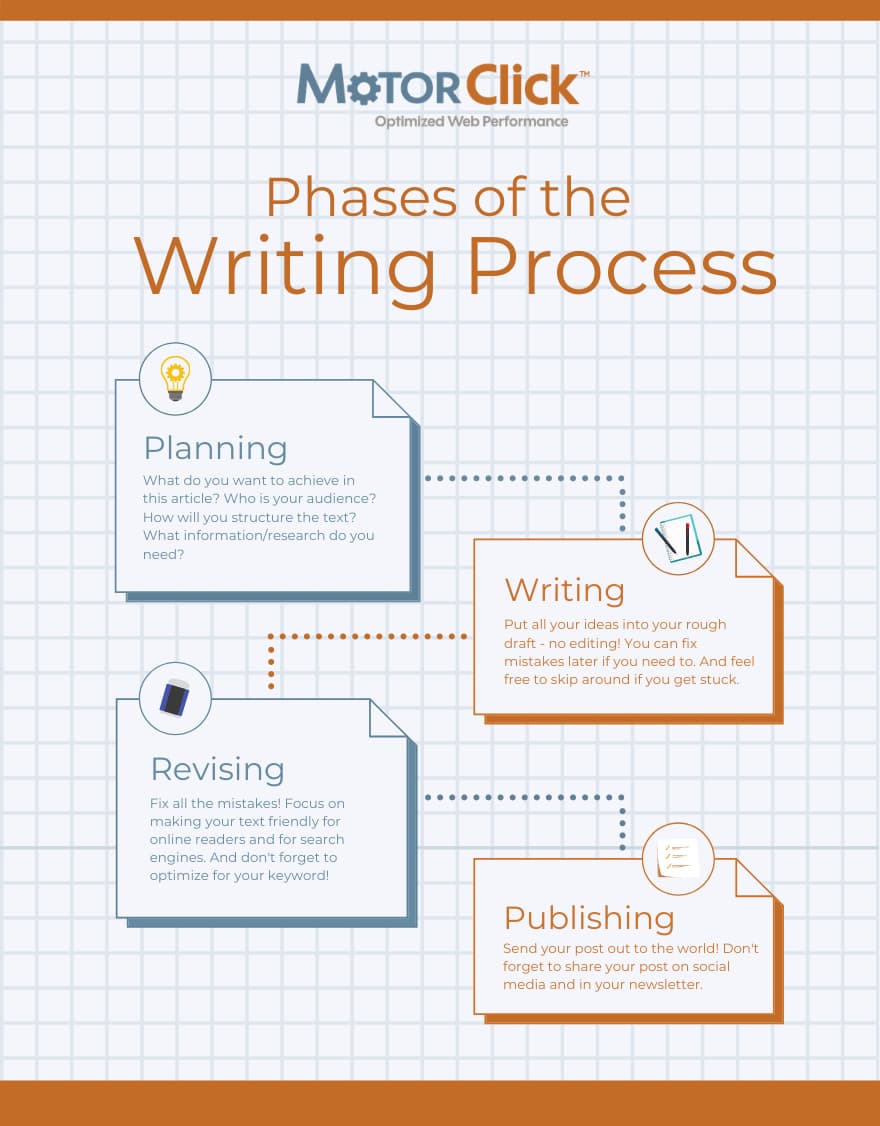You’ve decided to start a blog for your business – awesome! In order for that blog to be successful and work to your advantage, your posts need to top-notch. In this post, we’ll walk you through the steps to write a successful blog post from start to finish. Let’s get started!
Estimated reading time: 9 minutes
Depending on where you look, the writing process may look a bit different. When it comes to writing on a blog, we try to simplify this process a bit, while at the same time making it more specific to online content, SEO, and conversion. To make this a bit easier, we divide the writing process into four phases:

Within these phases, there are a number of steps, some of which may or may not apply to you and your business. So, as always, use your best judgment here when making decisions about your own blog posts.
1. Planning
Writing good content that will rank in the search results takes time. More than that, it takes proper preparation. Before you even think about what to write your post about, though, you need to make sure you’ve researched your keywords. Are these words that your ideal audience would be using when they search online? Are they words that generate enough traffic to be worth optimizing your post for?
Read On: How To Find Ideas For Blog Posts
Once you have a keyword you want to focus on for your post, you have to ask yourself a few questions. These questions will help you figure out what you want to say and to whom you want to say it. Let’s look at each question one at a time!
What is the goal of your post?
Before you start writing your post, you should think about why you’re writing it. What do you want to achieve with this article? Are you writing to persuade your audience, entertain them, or inform them? Keep in mind, your post can have multiple goals. For example, you may want to inform your visitors, but also entertain them. Understanding the purpose of your blog post helps shape your tone and gives you direction as you continue to plan your writing. A persuasive piece should be written differently than an informative or entertaining article.
What is the controlling idea?
Understanding the controlling idea, or the main message, of your post, is a crucial part of planning your writing. Think about what you want your readers to know or do after they’ve finished reading the article. We find it helpful to frame the controlling idea as a question: for example, ‘What are important things you should put on your website’s Contact page?’ You can then frame the main message of the post as the answer to the question: ‘Things like maps, images, accurate contact information, and a clear call to action can really make your Contact page stand out. Not only that, but they can improve the user experience of your page, which helps your SEO in the long run.’ Then, you simply take this answer and expand upon it, weaving in more details to give your readers more information. And voila! You have the makings of a great post!
Pro-tip: Put your main message in your introduction and in your conclusion. This helps your readers to quickly understand what you’ll discuss in your article, and helps them remember what they read when they reach the end. Just make sure you phrase things a bit differently; don’t just repeat yourself!
Who are your readers?
Knowing your audience is also an important part of planning a blog post. Who is this post for? Most of the time, your posts will be for the same target demographic as your ideal customer, but there are times when you might want to reach outside that zone and appeal to a wider audience. So carefully think about who your audience is, and adapt your writing to them. That means staying away from jargon and communicating to them in a way that they can easily understand.
Read More: What Every Business Owner Needs To Know About Their Customers
What resources do you need?
Depending on the kind of post you want to write, you may not need any external sources to help you. As an expert in your field, you probably have a lot of knowledge already that you can leverage in your blogs. However, some posts might require a bit more research.
Will you need to access certain books, blogs, studies, or peer-reviewed papers? Can you find everything from trusted, reputable sources online? Could you potentially ask another expert in your field for their input/opinion and use that as part of your content? The sky is the limit; just make sure the sources are legitimate!
How should you structure your post?
The last question you need to ask yourself in the planning phase of the writing process is how you will structure your text. How are you going to arrange the information you want to communicate to your readers? Depending on the purpose of your post, your controlling idea, and your audience, your structure will probably look a bit different. Try to organize your sub-topics in a logical way. For example, you could take a didactic approach, starting with the simplest information and working your way to the hardest. Alternatively, you could organize topics thematically and group them in a way that makes sense to your audience.
Read On: How To Make Your Blog Posts Easy To Read
The key to organizing your post properly is putting yourself in your readers’ place. What would they expect to read, and how would they expect to see the information organized? Whatever that is, give it to them!
2. Writing
Great work! Now you have everything you need to start writing your blog post! When writing the first draft, try not to worry about typos or mistakes or word count. During this part of the process, you just need to get the words written. You can always edit and polish later, before you publish. If you find yourself getting stuck on a particular section, skip it and move on. You can always return to that problem section another time.
Read More: Mistakes People Make When Writing Content For Their Websites
3. Revising
After writing the first draft, you need to sit down and edit. This means going back through and correction all those typos and errors. Additionally, it means making sure your text is readable and makes sense from one paragraph to the next. During this step, we recommend reading your blog post out loud; this can help you spot awkward wording and smooth out any weird transitions in your article. If writing isn’t your strong point, ask someone else to read the text and offer feedback. They might catch mistakes they you didn’t, or have suggestions for other ways you can improve the post.
The revision stage is also the phase in the writing process where you optimize your blog post for the search engines. This includes using your focus keyword throughout your text, creating a great meta description, and optimizing your images. By taking these steps, you make it easier for search engines to read and understand what your post is about. Which, in turn, leads to higher rankings in the search results (if you do this well!).
4. Publishing
You’ve finally made it! Your post is ready to go out into the online world. But first, there are a few things you don’t want to forget to do:
- Add your optimized images. Don’t forget to add high-quality, optimized images! You can create your own images, or use stock photos – whatever works for your business. At a minimum, you should have a featured image, which is what your readers will see when they click onto your article on your website. It’s also the image people will see if someone shares your post on social media.
- Choose a category/tag. Categories and tags help structure your blog’s content to make it easier for your visitors to find what they might be looking for. Before you publish your post, assign it to a category and/or tag, so your users can find it once it’s out there. Just make sure you use these taxonomies properly, or you could unintentionally sabotage your site’s SEO.
What to do after you publish
We’ve seen so many people just post on their blog and then do nothing, hoping people would just find it on their own. While this might happen, eventually, sitting back to wait isn’t the most effective strategy if you hope to generate meaningful traffic to your website. Instead, you should share your post on your active social media profiles – you can automate this process or do it yourself. Get that content out in front of your followers; the follow you for a reason!
Moreover, you should add internal links. These links are in the text of your article (you might see some in this post, too) that help Google understand how the different posts on your blog relate to each other. This, in turn, helps Google better understand your website, which leads to higher rankings in the search results.
Some time later…
After your post has been out there for a while, don’t let it just disappear into the black hole of the Web. There are a number of things you can do to prevent this from happening. Firstly, you can continue to improve your content, adding more details, updating sections, embedding videos and other media, etc. and republishing it. Secondly, you can include the posts in your newsletters. As long as the information in your post is still relevant, it doesn’t matter if it’s a couple weeks/months old. In addition to this, you can repost your article on social media. Just make sure you don’t overdo it and share the same things so often that your followers get annoyed.
Analyze and reoptimize
After a month or so, start analyzing your post’s performance, and come back once a quarter to see how that performance stacks up over time. Google Analytics does a great job of tracking which posts and pages receive the most visits and clicks. This helps you prioritize which posts and pages to improve first. You can also check Google Search Console to learn more about how people found your post and whether it is ranking for the keyword you wanted it to rank for.
Once you have an idea of how your post is performing in relation to all the other competition out there, you can go back in and reoptimize it wherever necessary. Not sure what to improve on? Hit the search results! Google your keyword and see what the top 5 sites in the search results are doing. Learn from them, and make your content better than theirs.
Go forth and blog!
If you take the time to plan your posts and edit and optimize them, they will definitely bring traffic to your site over time. Just remember to be patient and to invest time into your keyword research, so you don’t optimize for the wrong words. And once it’s written, don’t just let it fade into obscurity. Share your content with your audience and continue to improve your content. If you keep this up, over time, you will begin to see great results. And trust us: it will have been worth it!
Keep Reading: How To Get People To Read Your Blog Posts

